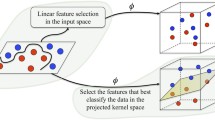Abstract
This paper derives the decision regions and the decision boundaries of the generalized K mean algorithms based on the L1 norm criterion, the L2 norm criterion and the L∞ norm criterion. The decision boundaries of these three generalized K mean algorithms are all linear hyperplanes. However, the total numbers of the decision boundaries of the generalized K mean algorithms based on both the L1 norm criterion and the L∞ norm criterion are more than that based on the L2 norm criterion. On the other hand, the decision regions of the generalized K mean algorithm based on the L2 norm criterion are convex while that based on both the L1 norm criterion and the L∞ norm criterion are in general nonconvex. The computer numerical simulations on a toy example demonstrate the above phenomena. Besides, two examples are illustrated. The first example on the patent image retrieval system shows that the recognition accuracies of using the generalized K mean algorithms based on the L2 norm criterion, the L1 norm criterion and the L∞ norm criterion are 58.25%, 61% and 58.75%, respectively. The second example on the electromyogram based Parkinson’s disease detection system shows that the recognition accuracies of using the generalized K mean algorithms based on the L2 norm criterion, the L1 norm criterion and the L∞ norm criterion are 60%, 60% and 67%, respectively, if the signals are classified directly in the time domain. On the other hand, the recognition accuracies of the generalized K mean algorithms based on the L2 norm criterion, the L1 norm criterion and the L∞ norm criterion are 60%, 87% and 60%, respectively, if the signals are classified directly in the discrete cosine transform domain. The improvements are due to the nonconvexity of the decision regions of the generalized K mean algorithm based on the L1 norm criterion and the L∞ norm criterion.







Similar content being viewed by others
References
Aslan MF, Durdu A, Sabanci K, Mutluer MA (2020) CNN and HOG based comparison study for complete occulusion handling in human tracking. Measurement 158:107704
Blumensath T (2016) Directional clustering through matrix factorization. IEEE Transactions on Neural Networks and Learning Systems 27(10):2095–2107
Chen L, Zhang H (2019) Statistical margin error bounds for L1-norm support vector machines. Neurocomputing 339:210–216
Dahlke S, Novak E, Sickel W (2010) Optimal approximation of elliptic problems by linear and nonlinear mappings IV: errors in L2 and other norms. J Complex 26(1):102–124
Dai, Yizhong, Weichao Kuang, Bingo Wing-Kuen Ling, Zhijing Yang, Kim-Fung Tsang, Haoran Chi, Chung-Kit Wu, Henry Shu-Hung Chung and Gerhard P. Hancke Sr. (2015) Detecting Parkinson's diseases inspired by characteristics of empirical mode decomposition of filtered noise. IEEE International Conference on Industrial Informatics, INDIN, 22–24 July, 2015. (Cambridge)
Forero PA, Kekatos V, Giannakis GB (2012) Robust clustering using outlier-sparsity regularization. IEEE Trans Signal Process 60(8):4163–4177
Jing L, Ng MK, Huang JZ (2007) An entropy weighting k-means algorithm for subpace clustering of high-dimensional sparse data. IEEE Trans Knowl Data Eng 19(8):1026–1041
Keysers D, Macherey W, Ney H, Dahmen J (2004) Adaptation in statistical pattern recognition using tangent vectors. IEEE Trans Pattern Anal Mach Intell 26(2):269–274
Lei T, Jia X, Zang Y, He L, Meng H, Nandi AK (2018) Significantly fast and robust fuzzy C-means clustering algorithm based on morphological reconstruction and membership filtering. IEEE Trans Fuzzy Syst 26(5):3027–30411
Lei T, Jia X, Zang Y, Liu S, Meng H, Nandi AK (2019) Superpixel-based fast fuzzy C-means clustering for color image segmentation. IEEE Trans Fuzzy Syst 27(9):1753–1766
Lin L-C, Chen R-B, Huang M-NL, Guo M (2020) Huber-type principal expectile component analysis. Computational Statistics and Data Analysis 151:106992
Liu B, Wu H, Weihua S, Sun J (2017) Sector-ring HOG for rotation-invariant human detection. Signal Process Image Commun 54:1–10
Liu Y, Liu T, Liu J, Zhu C (2020) Smooth robust tensor principal component analysis for compressed sensing of dynamic MRI. Pattern Recognition 102:107252
Papalexakis EE, Sidiropoulos ND, Bro R (2013) From k-means to higher-way co-clustering: multilinear decomposition with sparse latent factors. IEEE Trans Signal Process 61(2):493–506
Sahoo SK, Makur A (2013) Dictionary training for sparse representation as generalization of k-means clustering. IEEE Signal Processing Letters 20(6):587–590
Tan H, Yang B, Ma Z (2014) Face recognition based on the fusion of global and local HOG features of face images. IET Comput Vis 8(3):224–234
Tang K, Zhixun S, Yang L, Jiang W, Zhang J, Sun X (2019) Subspace segmentation with a large number of subspaces using infinity norm minimization. Pattern Recogn 89:45–54
The website of the patent image retrieval system: http://183.62.9.134:8081/imgsearch.aspx.
Tzortzis GF, Likas AC (2009) The global kernel k-means algorithm for clustering in feature space. IEEE Trans Neural Netw 20(7):1181–1194
Wang X-D, Chen R-C, Yan F, Zeng Z-Q, Hong C-Q (2019) Fast adaptive K-means subspace clustering foe high-dimensional data. IEEE Access 7:42639–42651
Wang Q, Gao Q-X, Sun G, Ding C (2020) Double robust principal component analysis. Neurocomputing 391:119–128
Zhang X-Z, Ling BW-K, Lun DP-K, Cao J, Dai Q-Y (2017) Image retrieval based on discrete fractional Fourier transform via fisher discriminant. Circuits, Systems and Signal Processing 36(5):2012–2030
Acknowledgements
This paper was supported partly by the National Nature Science Foundation of China (no. U1701266, no. 61372173 and no. 61671163), the Team Project of the Education Ministry of the Guangdong Province (no. 2017KCXTD011), the Guangdong Higher Education Engineering Technology Research Center for Big Data on Manufacturing Knowledge Patent (no. 501130144), the Guangdong Province Intellectual Property Key Laboratory Project (no. 2018B030322016) and Hong Kong Innovation and Technology Commission, Enterprise Support Scheme (no. S/E/070/17).
Author information
Authors and Affiliations
Corresponding author
Additional information
Publisher’s note
Springer Nature remains neutral with regard to jurisdictional claims in published maps and institutional affiliations.
Rights and permissions
About this article
Cite this article
Wang, X., Ling, B.WK. Decision regions and decision boundaries of generalized K mean algorithm based on various norm criteria. Multimed Tools Appl 79, 30669–30684 (2020). https://doi.org/10.1007/s11042-020-09402-7
Received:
Revised:
Accepted:
Published:
Issue Date:
DOI: https://doi.org/10.1007/s11042-020-09402-7




